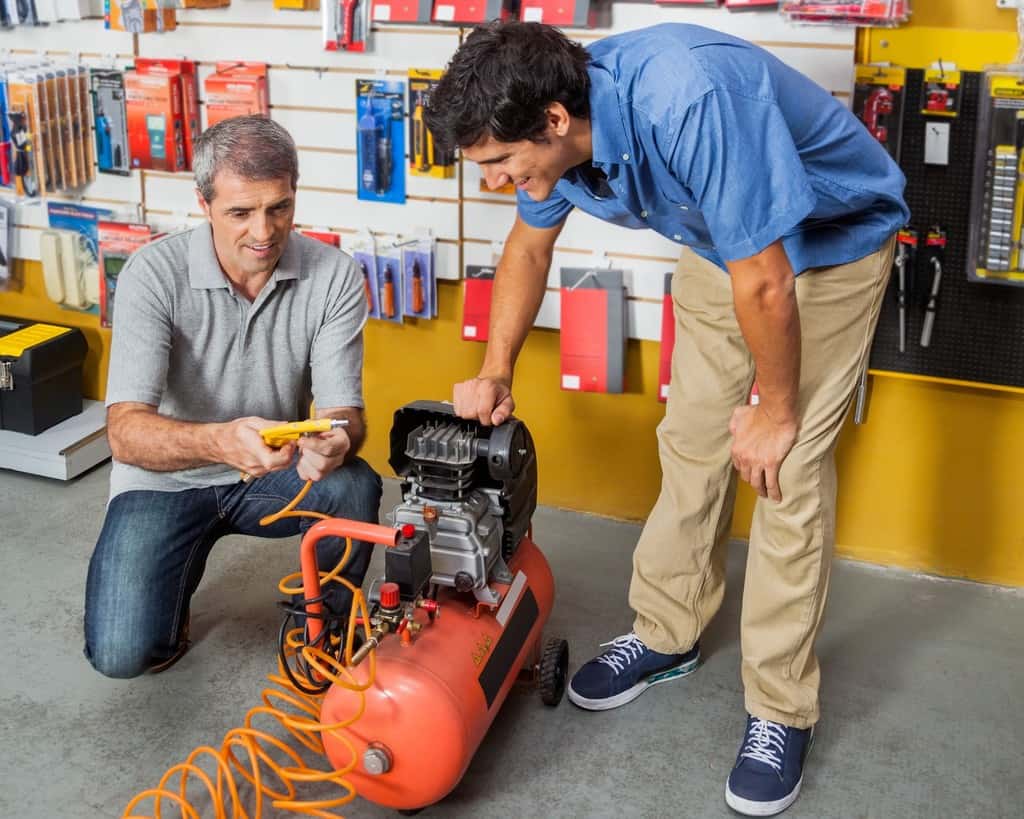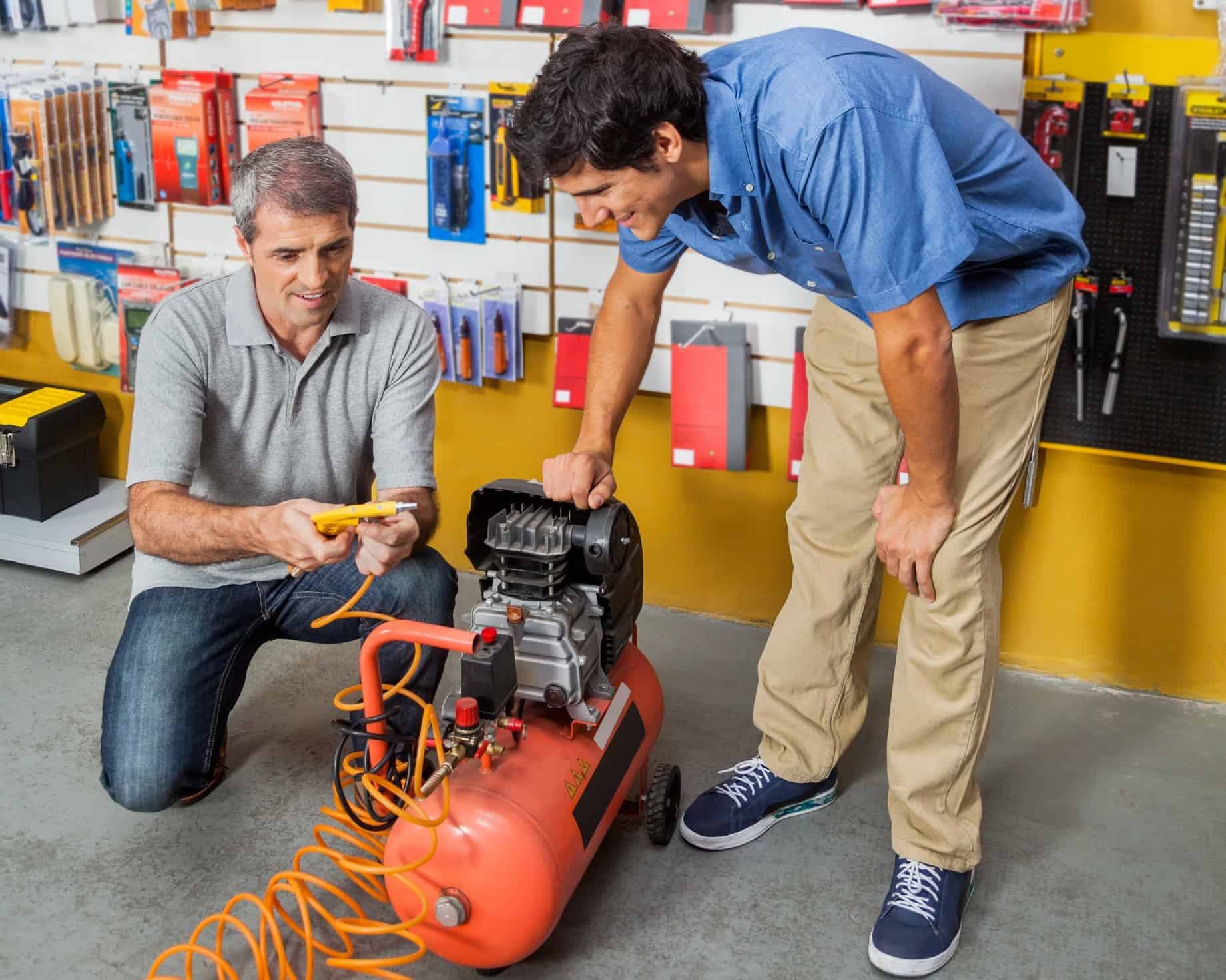
One of the most important aspects of operating tools is making sure that they have a proper energy source to keep them running. When you are using air tools, air compressors will be the answer here. From smaller, more compact and mobile units to larger ones, air compressors do just what the name would imply, compressing air flow in such a way as to store kinetic energy, which can then be used to power things.
What Is an Air Compressor?
Air compressors make use of PSI and the pressure generated by concentrated a great deal of air in a contained place. Different air compressors create that pressure in different ways, ultimately storing the air within a tank which is set to shut off once a specific pressure level is reached. Once it uses that energy and returns to a lower limit, the machine can be switched on and be used to generate pressure and energy once again.
It’s a simple yet efficient tool and one which is always useful to have on hand if you are using air tools rather than power tools.
The Bostitch BTFP02012 air compressor, with 6 gallons tank and 150PSI, accompanied by 3 air tools.
Check prices for this model and other air compressors on Amazon now.
It’s also a tool that you want to be careful about using. You don’t want to over pressurize the tank to the bursting point, and you want to make sure everything is hooked up properly so as to prevent a leak.
How to Use an Air Compressor in 7 Steps
This guide can take you through the process step by step to help you figure out how to use an air compressor (sources: wikihow, mitm). If you need to set up an air compressor for the first time, follow this detailed guidance.
Time needed: 1 hour
7 Steps to Use an Air Compressor
- Checking Oil Levels (for oil-based compressors)
Let’s start at the very beginning. The first thing that you are going to want to do to get your air compressor up and running is to check and see whether your unit is purely electricity and air-based, or whether it uses oil as well.
Some air compressors some utilize oil, and some do not. If your unit does use oil, you have an extra step to tackle here, as you’ll need to check the oil levels as you would the oil level of your car. If you are low on oil, you’ll want to screw off the cap to the oil storage area and refill it to the appropriate level, which will likely be demarcated for you. - Locate the Hose
You’ll now want to start attaching things, beginning with the hose. On many units, it should be located relatively close to the regulator valve and pressure gauge. You will next want to locate the right end of the hose to attach it to the correct part of your compressor. You can typically identify the proper part of the compressor by copper fixtures, such as a round copper slot.
- Plugging In
The next step towards getting your unit up and running is, of course, to plug it in. Make sure that your unit is switched to the “Off” position, locate the power cord, and plug it into the nearest available power outlet. Once you have done that, you’ll be ready to turn the power on. Extension cords can sometimes cause these units to overheat, so you’ll want to avoid them.
- Preparing Yourself
Now that you’ve gotten all that prep work out of the way, you’re almost ready to get started using your air compressor. You’ll first need to prepare yourself to use it, and that means putting on safety goggles, and noise-cancelling earmuffs may be a good idea if your unit is particularly noisy. You’ll also want to want to consider wearing a smock or other clothes that you don’t mind getting dirty if your unit takes oil.
- Test It
You’ll now want to test your unit to make sure that everything is working properly. In order to do that, you’ll want to locate the safety valve and pull it. You should hear a hissing sound. If you do, that means that the air is escaping out of the valve like it should be, which is a sign that everything is working and you’re good to go. If you don’t hear that sound, you may have a problem and will want to check everything.
Do not use your air compressor unit until you hear that sound and are able to completely verify that the safety valve is working properly. - Turn on the Tank and Work with Your Air Tools
Now, after all that preparation, windup, and explanation of how to use an air compressor, it’s time to finally turn it on and start using it to power whatever it is you wish to power.
In order to do this, you are first going to need to know how much pressure and thus energy the unit is producing. You should be able to do this by checking the pressure levels on the PSI indicator as the unit starts to work. Your air compression unit should have a readout of how much pressure is being generated at any given moment, making checking this all-important factor all the easier.
In addition, if you are using your air compression unit to power a tool, it should tell you how much is needed to power it.
Simply keep the unit plugged in, and have it continue generating the air pressure and electricity you need until you are ready to switch it off. - Turn Off the Tank
When you are finally ready to do that, you’ll want to make sure to turn everything off in a slow, careful manner. Simply yanking out the cord can damage your unit and be dangerous to your safety.
First, you’ll want to turn the unit off and open the tank drain valve. This should allow you to release any excess condensation, which is vital to do since leaving that within the unit can cause damage over time. You’ll then want to continue turning off the power switches on your unit to power it down, taking the time to shut off the air supply first. You’ll also want to remove and store the hose.
If your unit uses oil, you’ll want to check the levels again at the end and be sure to drain and replace it as needed.
Conclusion
There are many advantages of air tools compared to their electricity-driven relatives:
Air tools are light-weighted which prevents fatigue when working with them for a couple of hours, and they also do not require electricity.
The California Air Tools 2010A Air Compressor. Check the current price.
Air compressors, can be charged with air in advance and, if they are portable, brought to and used at any site even if it is not connected to the power grid. Using air tools requires a bit more of initial investment than regular power tools. However, for certain uses these types of tools are definitely the first choice.
Check out the latest deals for air-compressors on Amazon now!



